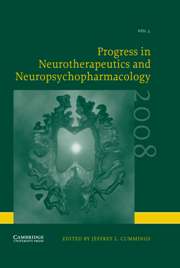No CrossRef data available.
Article contents
Use of Selegiline as Monotherapy and in Combination with Levodopa in the Management of Parkinson's Disease: Perspectives from the MONOCOMB Study
Published online by Cambridge University Press: 18 June 2007
Extract
ABSTRACT
The MONOCOMB study was a double-blind, randomized, controlled trial initiated to examine the impact of selegiline monotherapy on time to the start of levodopa therapy and, subsequently, to compare the progression of PD in patients treated with individualized levodopa plus selegiline or placebo.
Previously untreated patients with idiopathic PD (N = 157) were randomized to receive selegiline 10 mg/day or placebo until levodopa was required; experimental medication was then withdrawn for 8 weeks. Patients were then randomized to levodopa (50 mg/day, titrated in 50 mg/day increments to 150 mg/day) plus either selegiline or placebo. Treatment was continued until patients required additional antiparkinsonian therapy or up to 7 years after initial randomization. The primary efficacy outcome for the monotherapy phase of the study was time to introduction of levodopa. Primary efficacy endpoints for the combined therapy phase were: time to development of fluctuations in disability; and time to the addition of supplementary antiparkinsonian treatment.
Selegiline significantly delayed the time when levodopa therapy became necessary during the monotherapy phase, although mean total UPDRS scores at time of initiation of levodopa were similar in both groups. Selegiline was also associated with improvements in PD' symptom status and disability as reflected in a broad range of well-established indices. After the 8 week wash out period the disability of the clinical condition of the patients in the selegiline group was still significantly better in the selegiline group than in the placebo group. During the combination phase of the study, the use of selegiline as an adjunct to levodopa enabled a given degree of therapeutic effect to be achieved with a demonstrably lower total consumption of levodopa. Patients treated with selegiline plus levodopa also exhibited a distinct (p = 0.005) slowing in the anticipated increase in the UPDRS scores over time, as for example in a mean UPDRS total score after 5 years 10 points lower than in patients on levodopa and placebo. The emergence of motor (wearing-off) fluctuations was delayed by selegiline, and the proportion of patients experiencing these events was lower than with placebo (20% versus 34%; p = 0.053).
Mild gastrointestinal events were significantly more common with selegiline monotherapy than with placebo (12 versus. 3; p = 0.028). The overall rates of AEs during the combination therapy phase were 69% in the selegiline group and 54% in the placebo group (p = 0.053). Significantly more patients in the selegiline group reported nausea. Of the five deaths that occurred during the combination therapy phase of the study (selegiline N = 4, placebo N = 1) none was expressly attributed to study medication.
The results of MONOCOMB, among the largest and longest-duration placebo-controlled studies to report experience with selegiline monotherapy in early-phase PD, confirm that selegiline is effective in retarding the progression of early PD, that it has levodopa-sparing qualities in more advanced disease, and that it is reasonably well-tolerated in long-term use.
- Type
- Research Article
- Information
- Progress in Neurotherapeutics and Neuropsychopharmacology , Volume 3 , Issue 1 , January 2008 , pp. 49 - 71
- Copyright
- © 2008 Cambridge University Press




